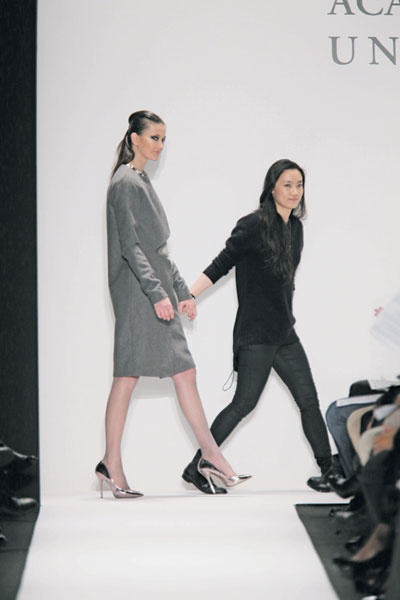
 |
|
Academy of Art University in San Francisco student designer Yuming Weng and a model walk down the catwalk during the university's Mercedes-Benz Fashion Week show on Feb 8 in New York. Randy Brooke / Getty Images via Academy of Art University |
Chinese students are flocking to US schools to find their own styles, Kelly Chung Dawson reports.
|
 |
|
 |
|
 |
China's growing luxury market and increased exposure to international fashion brands over the last decade have led to steep jumps in enrollment of Chinese students in US fashion schools, with many of those graduates expected to eventually return to China to grow an industry that still depends heavily on Western talent.
Applications from China to Pratt Institute's fashion program in New York have more than tripled in the past three years, jumping to 74 in 2013 from 21 in 2010, according to school officials. The Savannah College of Art and Design, which has a satellite location in Hong Kong, also reported increased enrollment, with 53 Chinese students currently enrolled in the school's fashion program, up from 13 in 2009.
"We have seen a major increase in both applications and enrolled students from China," said John Paul Rowan, formerly vice-president of SCAD Hong Kong and now vice-president for strategy and innovation at the school. "It's been wonderful to add that diversification to the student body, and we see that continuing to grow in the future. One only has to walk down the street in Shanghai and Beijing today and see the importance of fashion and street style, and how that's grown and changed in the last 20 years and definitely even in the last five years."
Hazel Clark, research chair of fashion at Parsons, the New School for Design, said the American view of Asia has shifted from a focus on Japan and South Korea toward China, which is reflected in a shifting ratio of students from each country.
"When I first arrived at Parsons, our Asian population was predominantly Korean and that is rapidly changing. One hears Mandarin spoken in the halls all the time, much more than before," she said.
In 2002, only two students from China were enrolled in Parsons' fashion programs; this past fall, the school welcomed 80 students from China with a focus on fashion.
Although China's universities also offer a number of prestigious fashion programs, Chinese students leave the country to study fashion in the US for various reasons, Rowan said.
"I do think there are some really good programs in China, and they're certainly doing a lot to grow those programs and grow the industry as a whole," he said. "But students choose to study internationally for a number of reasons, and the primary one is to gain broader exposure and get experience outside of Asia. With a school like SCAD, for example, students want to take advantage of our reputation and the professional collaborations and opportunities students get while going to school here."
